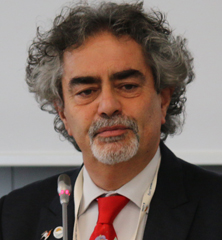You are here
Statement by Dr Fernando Spina on World Migratory Bird Day 2020

Dr Fernando Spina
Former Chair, Scientific Council of the Convention on Migratory Species (CMS)
[ Video Message ]
Last Sunday, while ringing in a beautiful inland wetland not far from Bologna, Italy, I handled several Garden Warblers. The birds were moving within wet bushes, where they intensively fed on elder berries. On average, the birds were around 20 grams in weight; surely not enough yet to be able to cross the Mediterranean and Sahara towards equatorial Africa. After relying largely on insects during their breeding season, for the past few weeks, they have now shifted to a diet largely based on berries and fruit, very rich in sugar, in order to fatten up quickly and store sufficient energy reserves to reach their wintering grounds. I was, as always as I have been for almost 40 years now, amazed while looking into their eyes as I released them back into nature to continue their adventurous journeys. Many of them were inexperienced juveniles on their first southbound migration, flying alone across unknown mountains and plains, looking for food in habitats never seen before, spending long nights of endurance and flights over inhospitable seas and deserts still lay before them.
When you think of bird migration, it looks simply unreal and impossible. Yet, they regularly do the impossible and by the thousands and millions. These days, countless birds belonging to hundreds of species move south along both the Eurasian-African and the Americas flyways, and it is surely not by chance that citizens, children, scientists and conservationists join forces with the Convention on Migratory Species and the African-Eurasian Waterbird Agreement to celebrate World Migratory Bird Day 2020.
The small Garden Warblers I ringed last Sunday will soon leave for the south along the Italian Peninsula. During these movements they will need to find suitable habitats to stopover, rest, feed and fatten before embarking on sea crossing towards North Africa and then further to the south. The sum of sites, habitats and food resources they will be using along the way and during the whole of their annual cycle and on the breeding and wintering grounds represents a complex system with no component less important than any other. In fact, these birds connect the whole ecological system represented by their flyways. Breeding grounds are not more important than moulting, staging or fattening sites; if any of the components of the system were missing or destroyed, the birds would not be able to accomplish their migration.
This concept of connectivity across sites, habitats, countries and continents is key for the conservation of all migratory birds and is therefore the keyword of CMS as the only convention for the conservation of all species of migratory animals. Connectivity is also the key idea behind the slogan of this year’s World Migratory Bird Day: “Birds Connect Our World”. Equally importantly, this ecological connectivity with the same individuals and populations visiting many and different countries during their annual cycles, implies sharing of responsibilities across these countries and calls for connectedness and coherence in the environmental policies influencing the conservation and future of migratory birds at the global level. Today more than ever we must work together to implement connected policies to ensure a future for migratory birds and for our only planet.
May the small and brave young Garden Warblers always find what they need to migrate safely between the shady boreal forests and the hot Sahelian savannahs; it is up to us, to give them - each of the billion birds crossing our night skies during World Migratory Bird Day 2020 – the respect and support they deserve.
Watch: Video Message by Dr. Fernando Spina
